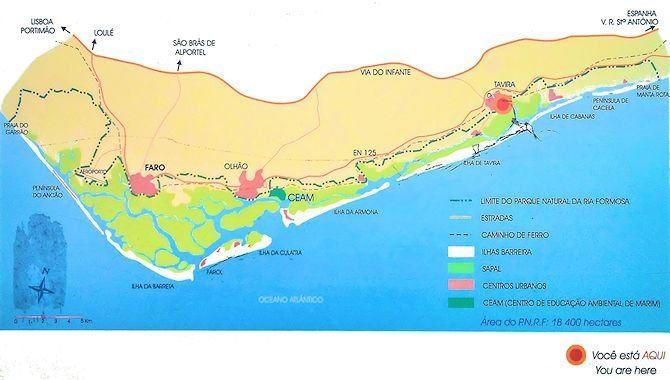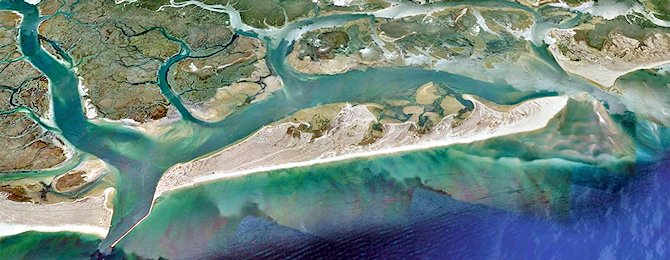
A
Earthcache
No texto abaixo, assim como no local das coordenadas, onde irá encontrar um painel informativo, poderá obter as informações necessárias para responder às seguintes questões. Estas devem ser respondidas para o meu
email de modo a poder fazer o registo como encontrada. Se tal não for feito o registo será apagado sem qualquer tipo de aviso. Não necessita de esperar pela minha autorização para efectuar o registo. Se existir algum problema será contactado(a) de modo a resolvê-lo.
- De que é constituído o fundo da Ria Formosa?
- De que ecossistema se fala no painel?
- Que pássaro está retratado no canto superior direito do painel?

The Earthcache
In the text below, as well in the place pointed by the coordinates, where exists an informative panel, one can find the necessary information to answer the following questions. These should be sent to my email in order to make a found log. Failing to do this will result in the deletion of your log without notice. You don't need to wait for permission to log. If there is a problem you will be contacted to resolve it.
- What composes the Ria Formosa's bed?
- Which ecosystem is referred in the panel?
- What bird is depicted on the top right corner of the panel?


Ria Formosa
A Ria Formosa é um sistema lagunar, com grandes áreas de sapal, situado no Algarve em Portugal, que se estende pelos concelhos de Loulé, Faro, Olhão, Tavira e Vila Real de Santo António, abrangendo uma área de cerca de 18.400 hectares ao longo de 60 quilómetros desde o rio Ancão até à praia da Manta Rota.
Os sapais são ecossistemas que ocorrem em zonas estuarinas, lagoas, lagunas e baías. Caracterizam-se por possuírem uma vegetação especializada que cresce em solos saturados de água salgada – vegetação halófita. Estas zonas contam-se entre as mais produtivas do planeta, possuindo também a capacidade de reter e degradar alguns poluentes. Na Ria Formosa existem extensas áreas de sapal que contribuem para a riqueza biológica e económica do sistema lagunar.
O seu fundo é constituído essencialmente por sedimentos lagunares (matéria orgânica, vasa salgada), sedimentos continentais (oriundos do transporte pelas ribeiras e escorrência das águas das chuvas) e sedimentos arenosos (provenientes das correntes de maré, sobretudo nas barras, galgamentos e ventos) que se têm vindo a consolidar com a ajuda da "morraça" que é um tipo de vegetação predominante e característico desta região.
Este sistema lagunar tem uma forma triangular e apesar de ser chamado de ria, na realidade não o é, uma vez que a laguna não é um vale fluvial, não existe um grande rio e é formada por ilhas barreira, como um cordão dunar. As dunas litorais constituem zonas de grande dinamismo, quer biológico quer geológico, sendo por isso extremamente frágeis. A vegetação que coloniza estas dunas possui adaptações morfológicas e fisiológicas extremas que lhe permite sobreviver naquelas zonas. Esta vegetação contribui para a agregação e fixação das areias. Tornando-se assim numa proteção eficaz desta zona costeira.


Ria Formosa
Ria Formosa is a lagoon system, with large areas of saltmarsh, located in the Algarve in Portugal, that stretch through the municipalities of Loulé, Faro, Olhão, Tavira and Vila Real de Santo António, spanning 18.400 hectares along 60 kilometres from the river Ancão till the Mata Rota beach.
The saltmarshes are ecosystems that appear in estuaries, lakes, lagoons and bays. They are distinguished by vegetation that grows in soils saturated with salt water – halophytic vegetation. These areas are among the most productive of the planet, having also the capacity to remove and degrade some pollutants. There are extensive areas of marshlands at the Ria Formosa, that contribute to the biological and economic wealth of this coastal lagoon system.
Its bed is mainly formed by lagoon sediments (organic material, salted silt), continental sediments (carried by streams and rainwater) and sandy sediments (carried by sea currents and wind). These sediments have been consolidated with the help of "morraça", characteristic and prevailing vegetation in this region.
This lagoon system has a triangular shape and although it is called "ria", in reality it isn’t, since the lagoon is not a fluvial valley, there is no major river and it is formed by barrier islands, much like a sand cordon. The coastal dunes are both biologically and geologically dynamic areas, therefore they are extremely fragile. The vegetation that colonizes the coastal dunes includes plants that possess extreme morphological and physiological adaptation, which enables them to survive in those areas. This vegetation contributes to the aggregation and settlement of the dunes, thus turning them into an effective protection of this coastal area.
